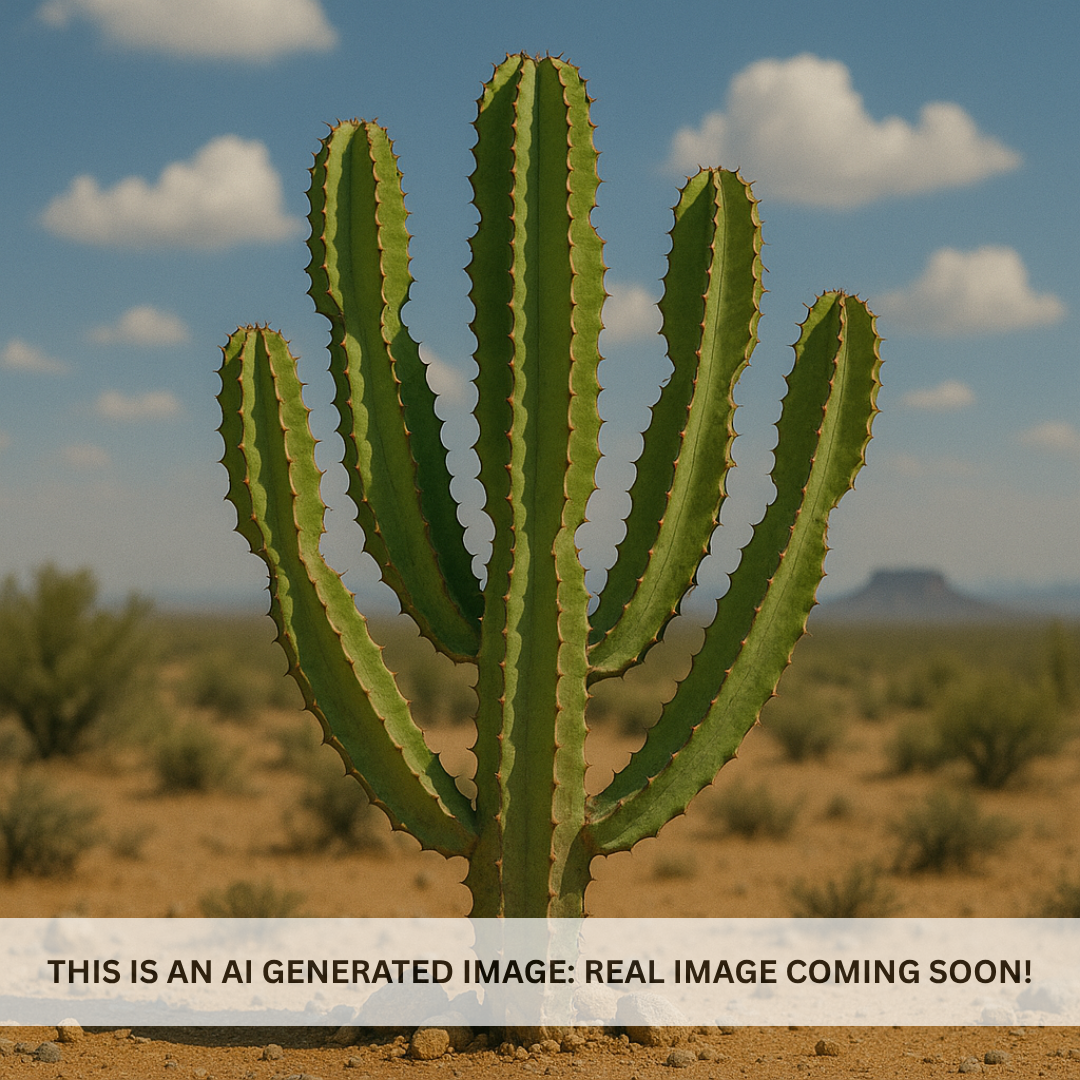My Store
African Candelabra
African Candelabra
Couldn't load pickup availability
Plant Type: perennial, succulent (candelabra-type euphorbia)
Plant Height: 10–20 feet (can exceed 25 feet in maturity)
Spread: 6–10 feet
Flower Color: small yellow-green blooms along ridges
Sun Exposure: Full sun
African Candelabra (Euphorbia ammak ‘Multi’): Towering Sculptural Elegance for Desert and Modern Landscapes
The African Candelabra (Euphorbia ammak ‘Multi’), also known as the Candelabra Tree or Arabian Candelabra, is one of the most dramatic and architecturally significant succulents in the desert plant world. With its upright, branching form and luminous blue-green color edged in creamy yellow, this plant evokes the elegance of a desert cathedral—graceful, commanding, and timeless.
Native to the arid highlands of the Arabian Peninsula, Euphorbia ammak thrives in full sun, extreme heat, and minimal water, making it a showpiece for Arizona’s climate. The “Multi” form refers to its multi-trunked habit, which develops several candelabra-like arms that rise and spread outward in balanced symmetry.
Key Features of Euphorbia ammak ‘Multi’
This species forms tall, columnar branches with four to five pronounced ridges per stem, giving it a sculptural, fluted appearance. The stems are smooth, slightly waxy, and a striking blue-green color with yellow or cream variegation along the ridges. Small paired spines line the ribs at regular intervals, adding fine detail without detracting from its clean architectural form.
Over time, Euphorbia ammak develops multiple trunks from the base, creating a dramatic candelabra structure that can reach over 20 feet tall and 10 feet wide. Small yellow-green flowers (cyathia) appear along the upper ridges in warm months, though the true appeal lies in its elegant silhouette and color contrast.
The plant’s milky white sap (latex) is toxic and can cause skin irritation—avoid direct contact when pruning or transplanting, and always use gloves and eye protection.
Growing and Care Tips
The African Candelabra thrives in full sun and well-draining, sandy or rocky soil. It is exceptionally heat-tolerant and prefers dry, open sites with excellent airflow.
During the first year after planting, water deeply every 10–14 days, allowing the soil to dry completely between waterings. Once established, water only every 4–6 weeks in summer and rarely in winter. Overwatering is the most common cause of decline and should be strictly avoided.
Euphorbia ammak is hardy down to about 25°F and should be protected during prolonged frost, particularly when young. It responds well to mild winter dormancy and will resume active growth in spring and summer. Fertilize once in early spring with a diluted succulent fertilizer to promote strong, upright growth.
When planting, take care not to damage the outer skin or ridges, as scars can persist. If pruning is necessary, allow any cuts to dry and callus before replanting or exposure to moisture.
Landscaping Uses
Euphorbia ammak ‘Multi’ is a premier statement plant for modern desert, Mediterranean, and resort-style landscapes. Its tall, sculptural form and luminous color make it ideal as a focal centerpiece, vertical accent, or architectural anchor near entryways, courtyards, or along structured walls.
It pairs beautifully with silver and blue-toned plants like Agave americana ‘Mediopicta Alba’, Blue Glow Agave, or Euphorbia tirucalli ‘Sticks on Fire’, creating contrast and rhythm in form and tone. Against gravel or decomposed granite, its creamy variegation and vertical structure appear almost luminous during sunrise and sunset.
In large containers, it brings instant sophistication to patios or poolside spaces, lending height and a refined sculptural presence with minimal care.
Summary
The African Candelabra (Euphorbia ammak ‘Multi’) is a living sculpture—an embodiment of desert resilience and elegance. With its glowing variegation, towering structure, and graceful branching, it adds drama and sophistication to any Arizona landscape. Fast-growing, low-maintenance, and enduring, it’s one of the most iconic euphorbias for modern outdoor design.
Three Timbers Installation Guide (Feel Free to Follow)
Euphorbia ammak ‘Multi’ Planting Guide
Location: Full sun exposure with at least six hours of direct sunlight daily. Choose an open area free of overhead structures to allow full vertical growth.
Soil: Use fast-draining sandy or rocky soil. A cactus/succulent mix with added gravel or pumice promotes excellent drainage and prevents root rot.
Spacing: Space 8–10 feet apart to allow for mature spread and branching.
Planting Depth: Set the base level with surrounding soil. Avoid covering the trunk or lower stems with mulch or soil.
Support: Tall, young specimens may need temporary staking during their first year to stabilize roots and vertical growth.
Watering Guide
Watering After Planting: Water deeply once after planting to settle the soil. Allow the soil to dry completely before watering again.
When is the Plant Established? The African Candelabra is considered established after 9–12 months, when consistent vertical growth and new branching occur.
Watering Once Established: Water every 4–6 weeks during summer and once every 8–10 weeks in winter. Reduce watering further during rainy periods.
Drip Irrigation Setup: Use one to two low-flow emitters (0.5–1 gallon per hour each) positioned 8–10 inches from the base. Allow complete drying between watering cycles.
General Watering Tips: Avoid overhead watering to protect the stems from rot and scarring. Use decorative gravel or decomposed granite to maintain dryness and complement the plant’s modern, clean aesthetic—keeping it several inches away from the base for airflow.
Share














